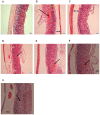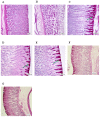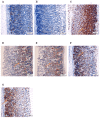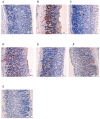Anti-ulcerogenic effect of methanolic extracts from Enicosanthellum pulchrum (King) Heusden against ethanol-induced acute gastric lesion in animal models
- PMID: 25379712
- PMCID: PMC4224391
- DOI: 10.1371/journal.pone.0111925
Anti-ulcerogenic effect of methanolic extracts from Enicosanthellum pulchrum (King) Heusden against ethanol-induced acute gastric lesion in animal models
Retraction in
-
Retraction: Anti-Ulcerogenic Effect of Methanolic Extracts from Enicosanthellum pulchrum (King) Heusden against Ethanol-Induced Acute Gastric Lesion in Animal Models.PLoS One. 2023 Nov 10;18(11):e0294008. doi: 10.1371/journal.pone.0294008. eCollection 2023. PLoS One. 2023. PMID: 37948333 Free PMC article. No abstract available.
Abstract
A natural source of medicine, Enicosanthellum pulchrum is a tropical plant which belongs to the family Annonaceae. In this study, methanol extract from the leaves and stems of this species was evaluated for its gastroprotective potential against mucosal lesions induced by ethanol in rats. Seven groups of rats were assigned, groups 1 and 2 were given Tween 20 (10% v/v) orally. Group 3 was administered omeprazole 20 mg/kg (10% Tween 20) whilst the remaining groups received the leaf and stem extracts at doses of 150 and 300 mg/kg, respectively. After an additional hour, the rats in groups 2-7 received ethanol (95% v/v; 8 mL/kg) orally while group 1 received Tween 20 (10% v/v) instead. Rats were sacrificed after 1 h and their stomachs subjected to further studies. Macroscopically and histologically, group 2 rats showed extremely severe disruption of the gastric mucosa compared to rats pre-treated with the E. pulchrum extracts based on the ulcer index, where remarkable protection was noticed. Meanwhile, a significant percentage of inhibition was shown with the stem extract at 62% (150 mg/kg) and 65% (300 mg/kg), whilst the percentage with the leaf extract at doses of 150 and 300 mg/kg was 63% and 75%, respectively. An increase in mucus content, nitric oxide, glutathione, prostaglandin E2, superoxide dismutase, protein and catalase, and a decrease in malondialdehyde level compared to group 2 were also obtained. Furthermore, immunohistochemical staining of groups 4-7 exhibited down-regulation of Bax and up-regulation of Hsp70 proteins. The methanol extract from the leaves and the stems showed notable gastroprotective potential against ethanol.
Conflict of interest statement
Figures









Similar articles
-
Methanol leaf extract of Actinodaphne sesquipedalis (Lauraceae) enhances gastric defense against ethanol-induced ulcer in rats.Drug Des Devel Ther. 2017 May 4;11:1353-1365. doi: 10.2147/DDDT.S120564. eCollection 2017. Drug Des Devel Ther. 2017. PMID: 28496305 Free PMC article.
-
Acute toxicity and gastroprotection studies of a new schiff base derived copper (II) complex against ethanol-induced acute gastric lesions in rats.PLoS One. 2012;7(12):e51537. doi: 10.1371/journal.pone.0051537. Epub 2012 Dec 10. PLoS One. 2012. Retraction in: PLoS One. 2023 Nov 10;18(11):e0294016. doi: 10.1371/journal.pone.0294016. PMID: 23251568 Free PMC article. Retracted.
-
Gastroprotective effect of desmosdumotin C isolated from Mitrella kentii against ethanol-induced gastric mucosal hemorrhage in rats: possible involvement of glutathione, heat-shock protein-70, sulfhydryl compounds, nitric oxide, and anti-Helicobacter pylori activity.BMC Complement Altern Med. 2013 Jul 19;13:183. doi: 10.1186/1472-6882-13-183. BMC Complement Altern Med. 2013. Retraction in: BMC Complement Med Ther. 2024 Apr 19;24(1):166. doi: 10.1186/s12906-024-04475-5. PMID: 23866830 Free PMC article. Retracted.
-
Prophylactic effects of Clausena excavata Burum. f. leaf extract in ethanol-induced gastric ulcers.Drug Des Devel Ther. 2016 Jun 15;10:1973-86. doi: 10.2147/DDDT.S103993. eCollection 2016. Drug Des Devel Ther. 2016. PMID: 27366052 Free PMC article.
-
Exploring the potential protective and anti-inflammatory effects of the crude ethanolic extract of Annona squamosa Linn fruit against Ethanol-mediated gastric erosion.Open Vet J. 2025 Feb;15(2):795-803. doi: 10.5455/OVJ.2025.v15.i2.28. Epub 2025 Feb 28. Open Vet J. 2025. PMID: 40201844 Free PMC article. Review.
Cited by
-
The gastroprotective effects of hydroalcoholic extract of Monolluma quadrangula against ethanol-induced gastric mucosal injuries in Sprague Dawley rats.Drug Des Devel Ther. 2015 Dec 30;10:93-105. doi: 10.2147/DDDT.S91247. eCollection 2016. Drug Des Devel Ther. 2015. Retraction in: Drug Des Devel Ther. 2023 Dec 09;17:3707-3708. doi: 10.2147/DDDT.S453787. PMID: 26766904 Free PMC article. Retracted.
-
Mechanism(s) of action underlying the gastroprotective effect of ethyl acetate fraction obtained from the crude methanolic leaves extract of Muntingia calabura.BMC Complement Altern Med. 2016 Feb 24;16:78. doi: 10.1186/s12906-016-1041-0. BMC Complement Altern Med. 2016. PMID: 26912079 Free PMC article.
-
Retraction: Gastroprotective Activity of Ethyl-4-[(3,5-di-tert-butyl-2-hydroxybenzylidene) Amino]benzoate against Ethanol-Induced Gastric Mucosal Ulcer in Rats.PLoS One. 2023 Nov 10;18(11):e0294007. doi: 10.1371/journal.pone.0294007. eCollection 2023. PLoS One. 2023. PMID: 37948322 Free PMC article. No abstract available.
-
Pulchrin A, a New Natural Coumarin Derivative of Enicosanthellum pulchrum, Induces Apoptosis in Ovarian Cancer Cells via Intrinsic Pathway.PLoS One. 2016 May 2;11(5):e0154023. doi: 10.1371/journal.pone.0154023. eCollection 2016. PLoS One. 2016. PMID: 27136097 Free PMC article.
-
UPLC-qTOF-MS Phytochemical Profile and Antiulcer Potential of Cyperus conglomeratus Rottb. Alcoholic Extract.Molecules. 2020 Sep 15;25(18):4234. doi: 10.3390/molecules25184234. Molecules. 2020. PMID: 32942704 Free PMC article.
References
-
- Brown LF, Wilson DE (1999) Gastroduodenal ulcers: causes, diagnosis, prevention and treatment. Comprehensive Therapy 25: 30–38. - PubMed
-
- Brucker MC, Faucher MA (1997) Pharmacologic management of common gastrointestinal health problems in women. Journal of Nurse-Midwifery 42: 145–162. - PubMed
-
- Laine L, Takeuchi K, Tarnawski A (2008) Gastric mucosal defense and cytoprotection: bench to bedside. Gastroenterology 135: 41–60. - PubMed
-
- Peskar B, Maricic N (1998) Role of prostaglandins in gastroprotection. Digestive Diseases and Sciences 43: 23S–29S. - PubMed
Publication types
MeSH terms
Substances
LinkOut - more resources
Full Text Sources
Other Literature Sources
Research Materials

